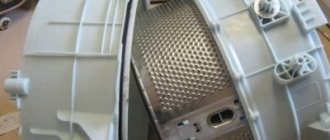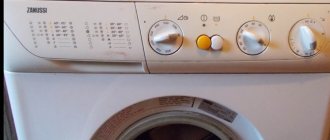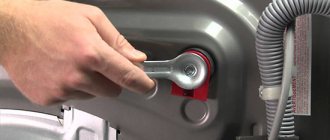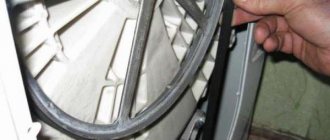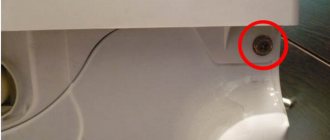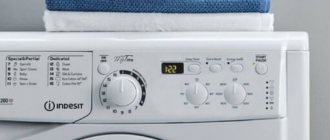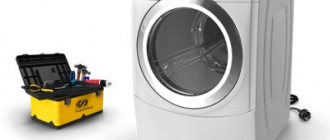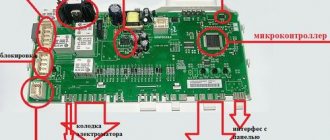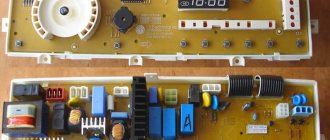If the drum of your washing machine dangles during the spin cycle or wobbles when you swing your hand while the machine is turned off, do not rush to worry. The washing machine tank with the drum is suspended from above on springs and rests on shock absorbers from below, so the entire structure can easily move in three possible directions - up and down, right and left, and back and forth. Even if the drum wobbles a lot during the spin cycle, this is not a disaster. Perhaps you simply overloaded the SMA, which is why it reacted with turbulence.
Additional signs of concern
A breakdown should be suspected if the drum play during spinning begins to be accompanied by certain symptoms:
- the unit rattles, and most of all - when spinning clothes,
- during the spin process, the drum begins to knock on the body part or on the glass loading hatch,
- the washing machine starts jumping or vibrating,
- The drive belt keeps falling off,
- the drum begins to rub against the cuff of the loading door,
- At first glance, the machine works fine, but the rotating drum makes squeaks and other noises,
- oily traces are visible under the unit,
- the machine begins to leak, there are traces of rust on the tank behind the rear panel,
- laundry is stained with oil or rust,
- the drum dangles a lot, then flies off and falls to the bottom,
- the washing machine chews the laundry,
- the drum jams and turns with difficulty, producing a metallic grinding sound,
- During operation, plugs are knocked out, smoke appears from the machine,
- The drum of the device is skewed.
Such a loose element, along with any symptoms, begins to signal a significant breakdown. And even in the case when the machine executes all programs, its operation is not recommended. When the drum of a washing machine dangles, more serious problems can be expected in the near future, including complete disposal of the device.
Failure options
The machine draws water for washing, but does not spin the drum
There are dozens of reasons for the situation when the washing machine will draw water into the tank to start the washing process, but will not be able to spin the drum. First of all, you should manually check whether the drum is spinning.
If it is easy to unwind by hand, then most likely the problem is either electronic or a broken or falling off motor drive belt. If it becomes worn, torn or stretched, it should be completely replaced with a similar one.
Drum does not spin during spin cycle
The washing machine drum may not spin during the spin cycle for several reasons:
- The washing program is set to “No spin” or “Delicate wash”. In this case, spinning will either not be carried out at all, or the minimum number of revolutions will be set so as not to stretch things.
- If the drain is clogged, the water will not be able to leave the tank and the electronic control unit of the machine will not start the spin cycle.
- If the water quantity sensor is faulty.
- There may be problems with the electronics and wiring of the control board.
Drum stopped during washing
The washing machine may stop the washing process if a lot of items have accumulated on one side of the drum. In this case, when there is an imbalance, strong vibrations occur.
At the same time, the electronic control unit gives a signal to stop washing, since an imbalance can lead to mechanical damage to the elements of the device and serious breakdowns.
Clogged hoses or a breakdown of the water level sensor in the tank can also cause the washing process to stop.
Always pay attention to the display - modern cars display error codes on it.
Washing cannot proceed without heating the water, so if the heating element malfunctions, the temperature sensor will give a signal to stop washing and the drum will stop along with the laundry. Touch the glass of the door: if it is cold, although the heating cycle is selected, then there is a problem with the heating element, most likely it will have to be replaced.
The same is true in the opposite situation - if the water temperature sensor is faulty, then the washing will be completed, since the control unit cannot monitor the current state and, accordingly, give a signal to continue working.
The motor hums, but the drum does not rotate
In a situation where the washing machine motor is running, but the tank does not turn, the cause may be jamming or mechanical damage to the device.
But the most common cause of this phenomenon is defects in the electric motor drive belt. It may tear or come off the pulley. In the worst of all cases - when it breaks, it wraps around the motor shaft, tearing it even more, which can cause damage to other elements.
If foreign objects get into the space between the tank and the drum, rotation may be difficult or completely blocked.
If the heating element or thermostat is damaged, the corresponding signals from the components of the washing machine do not reach the software control board, which leads to the drum not starting to rotate, although the motor is working.
The drum does not turn manually, it is jammed
There are several main reasons for a completely jammed washing machine drum: problems with the motor drive belt, problems with the bearing, and foreign matter entering the space between the tub and the drum through the rubber seal.
First of all, the bearing wedge is best diagnosed by related signs: it degrades for a long time, so unexpected failure is rare. Most often, for a long time the bearing will interfere with a strong grinding and humming noise when the machine is operating. It is also possible that the drum may have some play, and it will seem to rotate with force.
After this, at one point the drum will be completely immobilized, and it will also be impossible to turn it by hand. The reason may be either degradation of the bearing with subsequent failure, or its complete destruction. The second case will be accompanied by strong noise during the last washes before the breakdown.
Bearing wear
The drum is attached to the body using a pulley on which a bearing is mounted. When rotating, the drum rests on a bearing. And if during operation it wears out more than it should, or becomes bent, noise, grinding, and difficulty rotating the drum will appear in the operation of the machine. As a result, the vibration will increase, and the drum may jam, or vice versa, it will become very loose on the axis.
If wear occurs on the crosspiece on which the bearing is mounted, the lateral mobility of the drum will increase. During the spin cycle, the machine parts will rub strongly against each other and against the walls of the housing. This will cause additional deformation of the drum itself, up to the appearance of cracks on it. And cracks will cause water leakage. The operation of the machine will be accompanied by strong vibration, even moving it around the room.
Problems with shock absorbers
A characteristic sign of a faulty shock absorber is strong impacts of the drum during the washing process or during the spin cycle. To make an accurate diagnosis, you should open the hatch of the washing machine, pull the drum towards you, and then release it. If it begins to sway, instead of immediately falling into place, then this indicates a malfunction of the shock absorbers.
If such a breakdown is detected, you should no longer use the equipment. Otherwise, serious consequences may arise that are unlikely to make anyone happy. In this case, these parts are changed only in pairs.
Causes of breakdowns and the procedure for determining them
A certain percentage of play is built into the washing machine by the manufacturer; this is considered normal. And there is no extraneous noise. But when the conversation turns to a breakdown, you need to act as follows:
- The loading hatch of the washing machine opens, then you should grab the drum with your hands, moving it to the sides without much effort. After this, it must be twisted clockwise and in the opposite direction. If you notice a grinding sound, these are the initial signs of a problem.
- Turn on the washing machine and set the “spin” program to the highest limits. When chatter occurs during rapid rotation, it feels as if the drum has been thrown off its own axis, and loud noises are heard again. Why does this happen? Look for a problem in the bearing or shock absorbers.
- To reliably clarify the failure, it is necessary to inspect the bottom of the machine. In most cases, failure of bearing devices is accompanied by water leakage through moving parts located on an invisible part of the tank. There is a high probability that at the end of the wash a large puddle will appear under the machine. This means that it is high time to replace the seals and bearings.
- When significant knocking noises are heard, but there is no water leakage, the bearings should not be changed - check the shock-absorbing devices. And getting to them is much easier.
The initial stage, which does not involve disassembling the unit, will not help determine anything else. It is possible to finally understand where the problem lies only after penetrating under the body part.
Failure of springs and shock absorbers is usually recognized quickly. They are simply examined thoroughly, shaking them a little. If at least one failed spring is detected, or a broken shock absorber is found, we can assume that the breakdown has been identified and disassembling the tank itself will not be required. And if everything is in order with such elements, then you will have to disassemble the machine further to remove the tank.
Fault prevention
So, the causes of noise in a washing machine are varied. But all users can prevent many of these defects, or at least make them less common. The most important rule here is not to overload the device. It is also worth considering that washing several times in a row without a break for at least 1-2 hours contributes to wear and tear on the machine. There will be less extraneous sounds if you use washing at high temperatures only when there is a real need for it.
By cleaning the filter and pipelines, they help remove foreign matter from the drum when draining the water. By wiping the cuff after each wash, you prevent it from coming apart and touching the drum. It is also very important to use soft water.
If this is not possible, the use of softeners helps slow down the accumulation of scale on the heating element.
There are a few more recommendations:
- wash all items containing metal elements only in closed bags;
- periodically rinse the drain filter;
- ventilate the drum after finishing washing;
- secure all hoses and wires carefully;
- comply with all rules of transportation and connection to communications;
- follow all other instructions in the instructions.
Damage to shock absorbers
Shock absorbers fix the tank in the washing machine from below, dampening vibrations during washing and spinning. The more often you use the equipment, the more you overload it, the faster the shock absorbers will fail. Even under ideal operating conditions, shock absorbers wear out: the lubricant dries out, the piston becomes loose and moves freely. Therefore, during the spin cycle, the tank will begin to dangle, the machine will jump around the bathtub, the intensity of vibrations will increase, and the drum will begin to knock.
It is necessary to change both shock absorbers, then the load will be distributed evenly. If you change only one, the new spare part will quickly break and the problem will recur.
In some washing machines, dampers (shock absorbers) are accessible from below, and in others from above. The specialist unscrews the bolts securing the shock absorbers to the body, disconnects them and replaces them with new ones.
On some machines, dampers are accessible by removing the front panel. The specialist will perform the following actions:
- Remove the top cover of the machine by unscrewing the fixing fasteners on the back of the case and sliding the top panel.
- Remove the powder container and the lower plastic panel that covers the drain filter.
- Dismantles the control panel by unscrewing the fixing fasteners and disconnecting the cables.
- Remove the rubber cuff.
- Unscrew the bolts securing the front wall and remove it.
Once access to the shock absorbers is opened, the old spare parts are dismantled, new ones are installed, and the unit is assembled in the reverse order.
If you are not afraid to disassemble and repair equipment yourself, you can do it all yourself.
The tank is attached to the machine body on an axle. It is suspended from above by springs that compensate for its swinging. From below, its vibrations are compensated by shock absorbers and dampers. The following malfunctions can lead to increased drum play:
- Stretching, tearing or deformation of the upper springs.
- Deformation or rupture of shock absorbers.
- Wear of shock absorbers.
As a result of such phenomena, the backlash of the washing machine drum will increase. The tank will swing violently and rub against the body. Increased mobility can lead to loosening of the bearing, deformation of the tank itself and increased wear of all parts.
Replacing the part itself
Now you can proceed directly to solving the problem when the drum in the washing machine is hanging loose .
The disassembly process and bearing replacement may look like this:
- Unscrew the pulley bolts and remove it.
- Carefully knock out the shaft using a rubber hammer.
- Next you should deal with the bolts connecting the parts of the tank.
- Now you can see the bearing - it is knocked out with a chisel. After this, you need to remove the seals.
- At this stage, it is necessary to prepare a place for installing a new part by lubricating it with the selected product.
- Install new seals and bearings.
- This completes the repair procedure; all that remains is to reassemble everything in reverse order.
If the work seems simple, then you should not think for a long time and it is better to get down to business right away. Otherwise, if you have questions, it is better to call a specialist at home.
In addition, in some models the tank may not be dismountable, which significantly complicates the entire operation. In this case, if the drum of the Indesit washing machine is loose, then you should definitely seek professional help.
How to replace a shock absorber
To carry out such repair work, it is necessary to remove the rear housing cover, disconnect the drum from the motor shaft, and sometimes remove the electric motor. Due to the fact that during assembly the bearing is firmly pressed into the mount, it must be knocked out. In a number of models, it is possible to dismantle the crosspiece, and sometimes you have to remove the tank itself.
Particularly difficult are cases where the washing machine has a solid tank made of plastic or composite material. To access the drum, you have to cut it. Instead of the dismantled broken bearing, a new analogue is installed, then the machine is checked for rotation and the rigidity of the drum fastening, and assembly is performed in the reverse order. You can organize a trial run to test the device.
This element, like spring hangers, cannot be restored. A specialist will install new ones for you. Temporary measures will not help in such situations. You will have to remove the housing cover, loosen and remove the springs one by one to inspect the fastening points for integrity.
When the tank is freed, you can remove and change the shock absorbers, and hang the tank in its original place. If the old springs have lost their elasticity, they are replaced with new analogues. By the way, when performing work, the master must check the condition of the tank and the supporting bearing cross.
The repair is completed with assembly and testing.
Minor drum chatter in Ariston, Kandy, Bosch, LG or Samsung washing machines is provided for by the manufacturer from the very beginning. Backlash is necessary for the normal functioning of the device. But such rocking of the drum does not cause the formation of extraneous knocks during the washing process. But when they are heard during the spin cycle, it is recommended to take a number of actions:
- open the loading door, grab the drum with your hands, and twist it. If you hear a grinding noise, look for the problem.
- Indesit starts with an empty drum at maximum. If during rotation there is a feeling of large vibrations accompanied by noise, then it is necessary to inspect the bearings or shock-absorbing devices,
- pay attention to water that may leak from the machine,
- If you hear a grinding noise but cannot find a leak, replace the shock absorbers.
READ MORE: Stockrose 65 photos description of perennial flower varieties What are the differences with mallow How to grow pink stockrose in the garden Diseases and pests
Let's look at cases when it may be necessary to replace or replace the washing machine drum drive belt.
But a loose or torn belt indicates certain signs of trouble that need to be identified and eliminated.
After all, if it breaks, the belt can damage many electrical wires, sensors and other elements that are located in the back of the washing machine tank. We will also dwell on why the drum drive belt flies off or breaks.
V-belts. Installed on washing machines with asynchronous motors. In cross-section, such belts have the shape of a truncated triangle. The length of the belt is always indicated on the outside, according to which you can choose a new one if necessary. Made from tougher material. As a rule, they rarely tear.
The V-belt should be taut “like a string” and bend quite a bit in the middle. Otherwise, spinning problems and washing program failures may occur.
Installation of the fallen V-belt drive begins with the engine pulley, the remaining part is put on the drum pulley, after which carefully, forcefully rotating the drum pulley, we install the entire belt.
note
If the belt is stretched, you need to tighten it with the engine. To do this, you need to remove the belt, loosen the engine mounts, move it towards increasing the length of the belt, tighten the mount and install the belt. If the tension of the drive belt is not provided for by the design of the washing machine, then it must be replaced with a new one.
Poly V-belts. Installed on cars with commutator motors. In cross-section they have a jagged shape of several small wedges.
They differ in length, which is indicated in millimeters, as well as in shape (“H” or “J”) and the number of wedges, the shape of which depends on the teeth on the engine pulley.
For example, the designation on a poly V-belt “1287 H8” means that its length is 1287 mm, its wedges are shaped like “H” and their number is 8 pieces. The rest of the markings on the belt are not particularly important.
The tension of the poly V-belt must be such that the middle part can be wrapped around its axis 360 degrees, and further rotation must be very tight.
Separately, let’s say that on some models of washing machines (for example, narrow Siltal machines), poly V-belts are installed very tightly.
Important
This means that when putting the belt on the drum pulley, the belt may not appear to be the correct length.
But this is not true, you just need to use more force than usual when putting on the belt and rotating the pulley, being careful not to injure your hands.
Accelerated belt wear is a “disease” of narrow washing machines. All components and elements of such models are located close to the body, and the belt is no exception. When a narrow car is still new, the springs and shock absorbers work properly. But subsequently they wear out a little, the amplitude of the tank during spin increases and as a result the belt begins to touch the back wall of the case.
This ultimately leads to damage and stretching of the belt. Then it needs to be replaced, since the stretched belt subsequently flies off and can damage wires and other elements.
A broken belt can also be caused by a cracked or broken drum pulley. The fact is that it is made of an inflexible but fragile alloy, which, if the laundry is overloaded, imbalanced or the belt is incorrectly tensioned, may not withstand and burst.
When the bearings of a washing machine are worn out, this, in addition to extraneous noise, also causes vibration of the drum pulley, which increases with each wash. If you use a washing machine for a long time with worn bearings, the vibration of the pulley becomes so strong that the belt can stretch and fly off during spinning, and in some cases break.
Often, the reason why the washing machine belt comes off is a temporary imbalance of the laundry during the spin cycle. If the washing machine fails to evenly spread out the laundry before spinning, then during the spin cycle a sharp impact of the tank against the walls of the housing may occur. Strong shaking may cause the drive belt to fly off.
Therefore, it is recommended not to overload the washing machine and to properly place the laundry in the washing drum. Lay out each piece of laundry to avoid curling during washing.
Such a malfunction often occurs on vertical models of Brand brand washing machines with the end of ECO (economy option) after approximately 8-10 years of operation. The fact is that over a long period of operation of the washing machine, its plastic tank is deformed, as a result of which the drum pulley and the electric motor pulley gradually shift relative to each other.
This causes the belt on the drum pulley to move towards the washing machine tub. Subsequently, the belt shifts so much that part of its plane begins to hang over the plane of the drum pulley, and it flies off during the spin cycle.
The problem can be temporarily solved by moving the engine towards the housing wall. This can extend the life of your washing machine by six months or a year.
To eliminate the malfunction, it is necessary to replace the tank and possibly the drum, which is not economically profitable. Therefore, in the end, such a machine has to be replaced.
Often the cause of belt breakage is its drying out at the point of greatest bend, where the belt goes around the electric motor pulley. For some reason, this happens mainly on vertical models and after they decide to use the machine after a long break in work.
That is, the bent section of the belt, when left in this state for a long time, dries out and takes on a certain rigid shape. After the rotation begins, this section, which has lost elasticity, begins to stretch and breaks off.
At first, a quiet extraneous sound will appear during washing, spinning, even when manually turning the drum. Over time, the sound will intensify, and a strong buzzing sound can be heard during the spin cycle. Rust streaks are visible under the CM on the tank. The laundry does not wring well, it is covered in stains from oil and rust.
Ignoring the problem will cause the drum to wobble severely if you press lightly on it. Also, the belt will often fall off due to pulley play, and the drum will rub the hatch cuff. In extreme cases, the drum will jam, sometimes it falls down, so it is impossible to operate the machine.
Why is this happening? Over time, the seal becomes less airtight, water appears in the bearings, the lubricant is washed off and the balls in the bearings become rusty and destroyed. As the deformation progresses, the grinding noise of the rotating drum will intensify. Water will also start to drip through the bearings at the back of the drum. If water gets on a running motor, it will cause a short circuit and knock out the machine, causing the motor to smoke.
If you do not change the bearing and oil seal when these symptoms occur, the crosspiece, caliper and tank will become damaged over time and it will be much more expensive to repair the washing machine. In LG models with direct drive, drum play will damage the Hall sensor, so you need to urgently call a specialist.
READ MORE: Connecting the washing machine drain to the sewer
Stages of the technician’s work when replacing a bearing:
- Unscrew and remove all bolts on the rear panel.
- Removing the dispenser.
- Removing the control unit.
- Removing blocking.
- Removing the remaining fixing parts, removing the front panel.
- Loosening the clamp.
- Dismantling the counterweight and tubular electric heater.
- Disconnecting all cables, pipes, and belts from the tank.
- Dismantling the motor, after which the tank and drum are removed.
Stages of disassembling a tank by a master with changing bearings:
- The cuff (rubber seal) is removed.
- The tank is installed so that the pulley is accessible, the bolts securing the pulley are unscrewed, which is also dismantled.
- The shaft is knocked out, after which the bolts connecting the two parts of the tank are unscrewed, which are also separated.
- Old grease and dirt adhering to the bearing are removed.
- The bearing is knocked out, the seals are removed.
- The space is wiped and lubricated with lubricant.
- New seals with bearings are installed.
How to change a washing machine bearing?
To replace a bearing you will need the unit itself, seals, lubricant and specialized tools:
- Sets of socket, open-end and hex keys
adjustable wrench
Screwdrivers of different sizes and types
Rubber and metal hammers
Ideally, you need to purchase an original branded bearing. It should be selected according to the markings indicated on the unit body and in the details of the device passport.
The designs of models from the Samsung, Bosch, Candy, LG and Zanussi brands have significant differences, so there is simply no universal method for replacing bearings. The general procedure is as follows.
Disassembly
Free up space for repairs, place the machine in such a way that you can easily reach its back wall. Sequence of work:
- Remove the bolts holding the back panel
Remove the dispenser
Unscrew the screws securing the control unit and remove it
Remove other fasteners and remove the front panel
Loosen the clamp
Remove the counterweight and heating element
Disconnect all wires and pipes leading to the tank, remove the belt
Unscrew the motor, remove it
Carefully remove the rubber seal
Place the drum with the pulley up, unscrew the bolts that secure it, remove the pulley
Use a rubber mallet to hit the shaft several times to release it.
Unscrew the screws holding the tank halves, disconnect the drum
When removing parts, remember the location of the bolts and the wiring diagram so that during assembly you can return everything to its original position. It is better to place the drum on a table or any other flat, elevated surface. This will make it easier to work with.
Replacement
When the tank is completely disassembled, nothing interferes with access to the bearing. Wipe off any old grease. Use a chisel to knock out the bearing, then remove the seals. Treat everything with lubricant, install the oil seals and a new assembly, press them in using a hammer and chisel. Assemble the machine, observing the reverse order of steps.
Shock absorbers are faulty
The absence of puddles and loud knocks during spin cycles are characteristic symptoms of damage to shock absorbers. You can find out if they are the cause of the breakdown by lightly pulling the tank towards you. The drum has not returned to its place? This means the problem is definitely in the shock absorbers. Moreover, further operation of the equipment will lead to rapid wear of other components of the machine.
Foreign object stuck
During washing, a knocking sound is sometimes heard due to the presence of some foreign object in the tank. These could be keys, coins, buttons, rhinestones, or a bra wire. They can even pierce the tank at high speeds, so the device will jam and water will leak onto the floor. After removing foreign objects, it is necessary to check the parts for integrity and serviceability.
Other causes of breakdowns are a malfunction of the belt (stretched, frayed or torn), breakdown of the electronic control unit, or electric motor.
If you act incorrectly and connect the device to the system incorrectly, important parts of the washing machine will fail. Therefore, it is better not to carry out independent repairs, but to entrust the matter to a specialist.
If you hear a loud knocking and grinding noise while the washing machine is operating, the machine begins to turn the drum with difficulty, there is a possibility that a coin, a nut or a sock has fallen into the body, in a word, any small thing that can leak behind the drum. In addition, parts of a scattered bearing or shock absorbers may be in the tank. And then the car will make a loud grinding noise.
If foreign objects that get into the tank are small, they can pass through the drain pipe and get into the filter. It will be quite easy to get them from there. You will only need to unscrew the filter from the housing and clean it of foreign objects. Just first you need to put rags on the floor to remove the water that has spilled through the filter hole.
If foreign objects are located at the bottom of the tank, then they can be removed through the heating element hole. For some models, the heating element is located at the back, and then you just need to unscrew the back cover, unscrew the heating element and remove foreign objects. In some models, the heating element is located in the front. Then getting it out will be more problematic. A professional technician will help you deal with this case.
What to do to troubleshoot
Some breakdowns can be fixed with your own hands. But if repairs cause you difficulties or the equipment is under warranty, it is better to contact a service center. How to make your own repairs, read below.
Transport bolts
In models of any brand (Indesit, Ariston, Samsung), the mounting bolts are located at the rear. Simply turn the washer over to the back panel and unscrew the screws as shown in the picture.
Correct installation
It is important to position and install the machine correctly to avoid unnecessary vibrations. To do this, follow these basic recommendations:
- Prepare a stable base. The floor under the equipment must be level and durable. If this is not the case, then you can prepare a concrete base or podium yourself.
- Align the housing strictly level. The feet will help you adjust the installation. Tighten them to adjust the height of the MCA.
If, after fulfilling the requirements, the machine continues to hum and vibrate, use special pads. Read about the right choice in the article “Anti-vibration stands for a washing machine. We choose and compare.”
Why does the drum in the washing machine dangle and rattle?
Washing machine breakdowns are always an inconvenience for users. Especially if the drum dangles in the washing machine, making unpleasant, rumbling sounds. It is highly undesirable to continue using such a household appliance. There is a risk of damage to other critical components of the machine.
will carry out urgent diagnostics and repair of the device.
Just call us at the number, arrange a time for a service technician to visit, leave information about the symptoms of the malfunction, the brand and model of the washing machine, and the time of use.
You can call a specialist not only on weekdays, but also on weekends and holidays. We will arrive in any district of Moscow and St. Petersburg in the morning from 7:00, lunchtime and even late in the evening, as we work until 23:00.
If your washing machine is knocking, there may be several reasons for this knocking: improper installation of the machine itself, problems with one of the counterweights, a loose power filter, a slipped shock absorber or a broken spring, foreign objects between the drum and the tub, as well as problems with bearings.
First of all, before you panic, take a close look at the laundry in the washing machine. It happens that during the washing process, laundry rolls up into one laundry ball.
This happens especially often when you wash a set of bed linen, and the duvet cover serves as an excellent environment for the formation of this lump.
Advice
In this case, during the spin cycle, the washing machine jumps, jumping and moving all the built-in equipment in the neighborhood.
If there are no problems with the laundry, but there is still a knocking noise, then to figure out exactly why the washing machine is knocking and what to do about it, read below.
An unevenly installed washing machine can be a common cause of knocking.
Look carefully at your car to see if it is skewed in any direction; you can also use a special level and check for sure.
If the washing machine is standing with a clear distortion, then try to tighten the legs so that the washing machine stands level and stable. Special silicone supports can also help.
A very common breakdown when the washing machine knocks during the spin cycle is a loose weight or balancing stone. This thing looks different, but it has the same meaning.
The main task of this stone is to weigh down the tank and balance it. If the fastenings of the stone are weakened, then the load will perform the opposite function, further weakening the washing machine tank.
It is for this reason that the washing machine knocks during the spin cycle - the stone is no longer tightly pressed to the tank and begins to knock against it. At the same time, the stone weighs quite a lot, and if its mass hits the tank, over time the tank will be damaged.
There is no need to explain that in this case you will have to change the washing machine.
A loose balancing stone is one of the reasons why a car may jump
Where can you find this notorious stone? Typically there are two loads in a washing machine. One is mounted at the top, the second at the bottom on the front of the tank or at the bottom. There are exceptions, but they are rare. The material of the cargo varies.
Starting from ordinary cast iron blanks, ending with concrete blocks. The loads are secured with screws and nuts. Despite various tricks, in the form of nuts with rubber stoppers and various groovers, the weights still unscrew and begin to knock like steam hammers. To minimize damage, you just need to tighten loose connections.
note
In theory, after these manipulations, the knocking sound during the spin cycle of the washing machine should stop.
If the stone breaks, then only replacing it with a new one will help.
An equally popular misfortune is a broken or unscrewed surge protector. Its function is to extinguish electrical impulses from the washing machine and prevent them from entering the network of the apartment or house.
When the filter flies from its place, it begins to bounce around on the wires, like on a swing between the body of the washing machine and the tank, and knock vigorously against them. The sound is not very pleasant and, moreover, such movements can cause a short circuit.
To prevent this from happening, you need to securely secure the torn part in place.
Check how tightly the surge protector is attached
Also, the washing machine drum may knock if you have problems with the spring or shock absorber. What does it mean? The tank is suspended from the body of the washing machine using springs, and from below it rests on shock absorbers.
All this is needed in order to dampen the vibrations that occur during spinning at high speeds. Over time, the spring may burst and the shock absorbers may break, which will immediately lead to the characteristic knocking sound of the washing machine during the spin cycle.
Operating the machine is highly undesirable if the problem is a faulty shock absorber
If you are not in the habit of checking your pockets before washing and washing your underwear in special bags, then there is a high probability that a foreign object may be causing the knocking noise.
READ MORE: Feeding geranium pelargonium with iodine, how to water geranium with iodine and hydrogen peroxide for abundant flowering
A very common case is a bra underwire. At best, it will get stuck in one of the holes in the drum and will knock on the tank with each new revolution. Getting it will not be a problem. At worst, it will fall into the tank.
In this case, only disassembling the washing machine will help and it is advisable to seek help from specialists.
Video instruction: how to remove a foreign object from the washing machine tank
If the bearings “fly”, then knocking is less typical for this malfunction, but is possible.
As a rule, the washing machine rattles during the spin cycle, and over time this noise will only increase.
Important
In this case, we advise you not to delay for a long time, but to immediately contact specialists, otherwise repairs can take a toll on the family budget.
You can ask them in the “Questions and Answers” section in the topic
Sometimes a situation arises when during a spin cycle the sound intensifies, a grinding sound appears and the machine begins to vibrate strongly. The reason for such manifestations is a malfunction of the counterweight.
A balancing block is attached to the drum, which dampens vibration during spinning at high speeds. When using the machine for a long time, the fasteners that secure the counterweight wear out. Instead, the counterweight begins to sway with the machine, increasing its vibration. And loud knocks appear when parts of the counterweight hit the tank body.
Such malfunctions are quite rare. But it’s better not to try to fix them yourself; in repairs, the technician uses special equipment, without which you will likely damage more parts than repair them.
What to do?
Having discovered the reason that the drum is loose, you can try to fix the washing machine yourself. Changing a bearing or shock absorber is quite easy; you can do it even without special knowledge in repairing household appliances.
Instructions for removing bearings and shock absorbers:
- disconnect the washing machine from the power supply and move it away from the wall;
- remove the back panel by unscrewing all the fasteners with a screwdriver;
- remove the washing powder feeder from the front panel;
- remove the control unit, having previously photographed the location of the wires, then secure the wires to the side wall of the device;
- remove the clamps that hold the rubber cuff.
- tighten the cuff itself;
- unlock the hatch;
- unscrew the fasteners that secure the front panel and remove it;
- remove the drive belt;
- disconnect the wires going to the heating element (before doing this, do not forget to photograph their location);
- pull out the pipe connecting the tank to the pump;
- remove the engine by unscrewing the bolts on which it is secured;
- remove the shock absorbers and return springs;
- Using a hammer and chisel, remove the drum pulley from the screw (to do this you need to slightly loosen it);
- using suitable tools, knock out the tank and pull it out;
- Now we need to remove the drum from the tank: if the tank is detachable, this will not be difficult, but for a solid tank we cut it along the weld seam, after which we carefully pull the drum out of it;
- We also carefully knock the bearings out of their sockets and take out the seals;
- Before replacing worn or damaged parts, we clean the fastening points from dirt.
To see the entire process of disassembling the washing machine and installing the shock absorber, see the video below.
The following video will help you remove and replace the bearing on a washing machine tank yourself, using Samsung as an example. For instructions on replacing bearings on machines of other brands, see our article “Replacing a bearing in a washing machine with your own hands.”
Minor swaying of the drum is provided for by the design of all washing machines, without exception, but a heavily dangling tank is a sure sign that the equipment will soon fail. It is important not to wait for an emergency stop or a water spill and to begin repairs immediately. The choice between “fix it yourself” or “seek help from specialists” depends on the complexity of the breakdown and the presence of associated damage, which can only be identified based on a thorough diagnosis.
Tools needed for repair work
It all depends on the type of damage. If you need to change shock-absorbing elements or springs, then all you need are flat-head and Phillips screwdrivers, an awl, some keys and a repair kit suitable for this model. And if bearings need to be changed, then a wider range of items will be needed:
- hammer with striker made of copper,
- rod or pin made of steel material,
- sealant (cold welding),
- set of screwdrivers and awl,
- open-end wrenches and a set of sockets,
- pliers,
- special lubricant for washing machine parts,
- bearings and seals included.
The shaft is removed from the drum pin with a copper hammer, because this type of striker will not damage the part. A steel rod or other suitable device is needed to knock the bearings out of their seats. The main thing is that such a device must be long and suitable in thickness.
Welding or sealant will be needed when in some model of washing machine the tank turns out to be one-piece. It will have to be sawed along the seam, then the connection will be made. Using an awl, the stuffing box elements are pryed up, pulled out, all fasteners are unscrewed with screwdrivers; keys are needed for the same purpose. Lubricant is applied to shock-absorbing elements and seals.
How to replace washing machine shock absorbers
Most modern models have specific shock absorbers - dampers. Finding repair kits or spare parts for them is almost impossible, so the worn-out part is replaced with a new one, and they are replaced in pairs. To manipulate dampers you need:
- Flathead and Phillips screwdrivers
Set of open-end wrenches
Components suitable for the washing machine being repaired
In most devices used, to get to the shock absorbers, it is enough to remove the front panel by unscrewing the screws that secure it, removing the powder tray, disconnecting the control panel and door lock wires. Remove the damaged dampers and reassemble the machine. What to do if difficulties arise during the disassembly (assembly) process? It’s better not to take risks and call a specialist, because we are talking not just about wiring, but about the “brains” of the machine, damage to which can greatly increase the cost of repairs.
A foreign object is rattling in the washing machine
Often the causes of strange sounds in the car are foreign bodies caught in the drum. Owners often forget small change, keys and other small metal items in the pockets of clothes being washed. Buttons and rhinestones that flew off during the spin cycle, bra underwire - there are a lot of culprits for knocking in the tank.
The main danger of foreign objects getting into the tank is the risk of jamming the device and causing holes. After removing unnecessary objects, it is worthwhile to diagnose other components of the machine that could also be damaged during operation of the device.
Other drum faults
Your washing machine may make a variety of loud noises during all phases of the wash cycle: washing, rinsing, and spinning. This always indicates some kind of malfunction or the presence of foreign objects in the tank body. In addition to the breakdowns described above, this may be a malfunction of the surge protector fastening.
Our company’s specialists will quickly and efficiently repair your equipment. Before repairing, the technician will perform a complete diagnostic of the machine. The price for repairs depends on the faults identified and the complexity of the repair. We repair washing machines of such brands as LG, Indesit, Candy, Ardo, Zanussi, Electrolux, Bosch, Beko, Samsung and others.
The FixWasher workshop accepts applications for repairs of washing machine drums every day from 7:00 to 23:00 by calling 8(495)228-42-92.
Cause Detection
It should be noted that the presence of a certain backlash is provided directly by the manufacturer. When the washing machine rocks, the drum will also rock, but not much. This phenomenon is normal.
At the same time, you should open the door and twist the drum with your hands; if you hear grinding, knocking and other unpleasant extraneous sounds, this clearly indicates a breakdown. Why does the LG washing machine drum hang loose? Typically, this may be due to problems of the following nature:
- bearing failure;
- shock absorber wear;
- presence of foreign objects;
- failure of seals.
You can feel the “bumpiness” of the drum by moving it a little from side to side. But how can we determine what exactly caused the uncharacteristic behavior of household appliances?
Advice from the experts
If the drum of your washing machine dangles during the spin cycle or wobbles when you swing your hand while the machine is turned off, do not rush to worry.
The washing machine tank with the drum is suspended from above on springs and rests on shock absorbers from below, so the entire structure can easily move in three possible directions - up and down, right and left, and back and forth.
Even if the drum wobbles a lot during the spin cycle, this is not a disaster. Perhaps you simply overloaded the SMA, which is why it reacted with turbulence.
A malfunction should be suspected only when play in the washing machine drum is accompanied by the following additional symptoms, one or more:
- The washing machine makes a lot of noise, especially during the spin cycle.
- During the spin cycle, the drum knocks on the SMA body or on the glass of the hatch
- The machine jumps or vibrates strongly during the spin cycle
- The belt regularly falls off the pulley
- The drum rubs against the hatch cuff
- The machine seems to wash and spin normally, but it makes noise or creaks when the drum rotates
- Traces of an oily dark liquid are visible under the washing machine
- SM leaks from below, if you remove the back wall, rusty traces of leaks are visible on the tank
- The washing machine stains the laundry with black oil or rust stains
- The washing machine drum flew off and fell to the bottom of the tank
- The drum is jammed and rotates heavily with a metallic grinding noise.
- SMA chews on things
- The washing machine breaks plugs or smokes
- SM drum warped
Possible breakdowns
Dispatchers of the “Community of Masters” always record the malfunction described by the client and transmit the description to the master. Here are the main breakdowns in which our customers complained that the washing machine drum was loose.
* Spare parts necessary for repairs are not included in the price and are paid additionally. The exact price depends on the brand and model of the washing machine and is determined after the technician diagnoses the problem.
7
Within 24 hours after your call, the technician will come to your home at any time convenient for you, diagnose the unit and, if necessary, repair it, returning the machine to its previous performance. All work and spare parts are guaranteed for up to 2 years!
If there is a problem with a bearing or shock-absorbing device, then all elements should be replaced, because a failed part will soon lead to a chain of problems from its analogues. And when you have disassembled the washing device, immediately change the seals, which also have operating limitations and wear out quite quickly.
Remember that machines from different manufacturers differ in their design and are disassembled in different ways. This feature should also be taken into account when undertaking repair work on your own.
Disassembling the unit tank and removing the bearings must be done correctly. There are washing machines in which it is possible to get to the shock absorber through the top of the machine or through its bottom. This convenient feature helps save time during repairs - you don’t have to remove the panels.
Reverse counterweight function
If vibration combined with knocking is observed during the spin mode, this may also indicate problems with the counterweight. The heavy block that is placed inside every washing machine is designed to dampen vibrations, which is why it is called a balancing element.
At the same time, if the fastenings are no longer able to hold it, the balancer begins to gradually collapse. Because of this, the block no longer performs its functions. The element, instead of dampening vibrations, begins, on the contrary, to rock the washing machine. Then you shouldn’t be surprised that the drum in the Samsung washing machine is loose. And the loud noise is precisely the sound of the balancing block hitting the tank.
Fortunately, counterweight problems are extremely rare. But even if this happened, this is exactly the case when it is necessary to call a specialist. This is due to the fact that it is necessary to carefully adjust the bolts or replace the old massive part.
